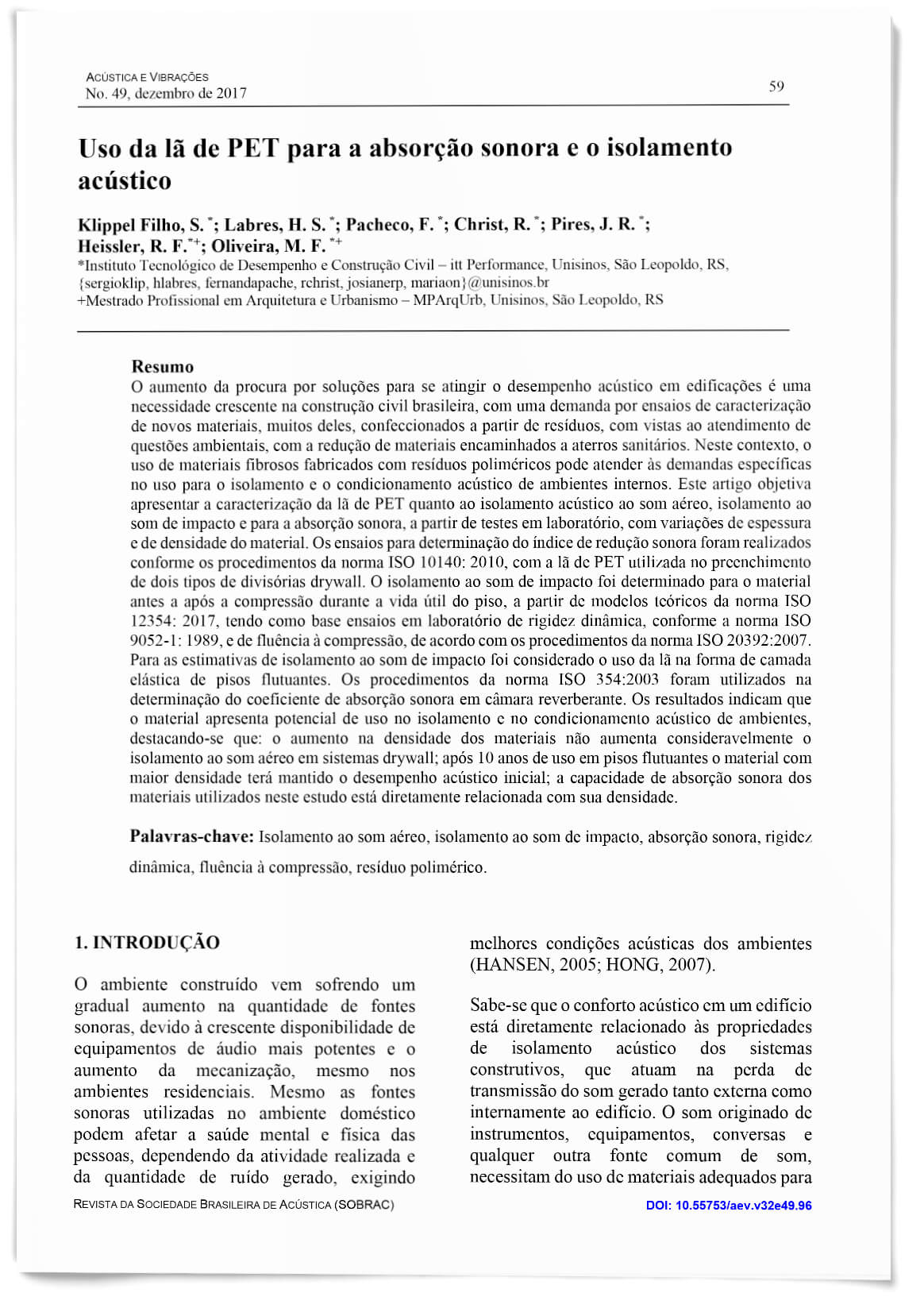Use of PET wool for sound absorption and sound insulation
DOI:
https://doi.org/10.55753/aev.v32e49.96Keywords:
airborne sound insulation, impact sound insulation, sound absorption, dynamic stiffness, compression creep, polymeric residueAbstract
The increasing demand for solutions to achieve acoustic performance in buildings is a growing need in Brazilian civil construction, with a demand for characterization tests of new materials, many of them made from waste, with a view to meeting environmental issues, with the reduction of materials sent to sanitary landfills. In this context, the use of fibrous materials manufactured with polymeric waste can meet the specific demands in use for the insulation and acoustic conditioning of indoor environments. This article aims to present the characterization of PET wool in terms of acoustic insulation against airborne sound, insulation against impact sound and for sound absorption, based on laboratory tests, with variations in thickness and density of the material. The tests to determine the sound reduction index were carried out according to the procedures of ISO 10140:2010, with PET wool used to fill two types of drywall partitions. Impact sound insulation was determined for the material before and after compression during the floor's service life, based on theoretical models from ISO 12354:2017, based on dynamic stiffness laboratory tests, according to ISO 9052 -1:1989, and compression creep, in accordance with the procedures of ISO 20392:2007. For the impact sound insulation estimates, the use of wool in the form of an elastic layer of floating floors was considered. ISO 354:2003 procedures were used to determine the sound absorption coefficient in a reverberant chamber. The results indicate that the material has potential for use in the insulation and acoustic conditioning of environments, highlighting that: the increase in the density of materials does not considerably increase the insulation to airborne sound in drywall systems; after 10 years of use on floating floors, the material with the highest density will have maintained its initial acoustic performance; the sound absorption capacity of the materials used in this study is directly related to their density.
References
ARENAS, J. P.; CROCKER, M. J. Recent trends in porous sound-absorbing materials. Sound and vibration, 2010. v. 44, p. 12–17.
ASDRUBALI, F.; SCHIAVONI, S.; HOROSHENKOV. A review of sustainable materials for acoustic applications. Building Acoustics, 2012. v. 19, n. 4, p. 283-311. doi: 10.1260%2F1351-010X.19.4.283 DOI: https://doi.org/10.1260/1351-010X.19.4.283
BRANDÃO, E. Acústica de salas. São Paulo: Edgard Blucher, 2016.
CRIPPS, A; FOVARGUE, J. Crops in Construction Handbook. London: CIRIA, 2004. 112 p.
EGAN, D. Architectural Acoustics. New York: McGraw-Hill, 2014.
GUILLEN, I. et al. On the sound insulation of masonry wall façades. Building and environment, 2008. v. 43, n. 4, p. 523–529. DOI: https://doi.org/10.1016/j.buildenv.2007.01.010
HANSEN, C. Noise control - from concept to application. London: Taylor & Francis, 2005. doi: 10.1201/9781315274911 DOI: https://doi.org/10.1201/9781315274911
HONG, Z. et al. A novel composite sound absorber with recycled rubber particles. Journal of sound and vibration, 2007. v. 304, n. 1–2, p. 400–406. doi: 10.1016/j.jsv.2007.02.024 DOI: https://doi.org/10.1016/j.jsv.2007.02.024
HUANG, C.-H. et al. The efficacy of coconut fibers on the sound-absorbing and termal insulating nonwoven composite board. Fibers and polymers, 2013. v. 14, n. 8, p. 1378–1385. doi: 10.1007/s12221-013-1378-7 DOI: https://doi.org/10.1007/s12221-013-1378-7
INTERNATIONAL ORGANIZATION FOR STANDARDIZATION. ISO 12354 – Building acoustics: Estimation of acoustic performance of buildings from the performance elements – Part 2: Impact sound insulation between rooms. 2017.
______. ISO 10140 - Acoustics: laboratory measurement of sound insulation of buildings elements - Part 5: Requirements for test facilities and equipment. 2010a.
______. ISO 10140 - Acoustics: laboratory measurement of sound insulation of buildings elements - Part 2: Measurement of airborne sound insulation. 2010b.
______. ISO 10140 - Acoustics: laboratory measurement of sound insulation of buildings elements - Part 4: Measurement procedures and requirements. 2010c.
______. ISO 11654 - Acoustics: Sound absorbers for use in buildings – Rating of sound absorption.1997.
______. ISO 20392 – Thermal-insulating materials: Determination of compressive creep. 2007.
______. ISO 3382 - Acoustics: Measurement of room acoustic parameters - Part 2: Reverberation time in ordinary rooms. 2008.
______. ISO 354 - Acoustics: Measurement of sound absorption in a reverberant room. 2003.
______. ISO 717 - Acoustics: Rating of sound insulation in buildings and of building elements - Part 1: Airborne sound insulation. 2013.
______. ISO 9052 - Acoustics: Determination of dynamic stiffness – Part 1: Materials used under floating floors in dwellings.1989.
LOU, C. W.; CHEN, P.; LIN, J. H. Manufacturing process and property analysis of sound absorption sandwich board. Advanced materials research, 2008. v. 55–57, p. 393–396. DOI: https://doi.org/10.4028/www.scientific.net/AMR.55-57.393
MACDONALD, W. A. New advances in poly(ethylene terephthalate) polymerization and degradation. Polymer international, 2002. v. 51, n. 10, p. 923–930. doi: 10.1002/pi.917 DOI: https://doi.org/10.1002/pi.917
MAEKAWA, Z.; RINDEL, J. H.; LORD, P. Environmental and architectural acoustics. 2. ed. New York: Spon Press, 2011. doi: 10.4324/9780203931356 DOI: https://doi.org/10.4324/9780203931356
PACHECO, E. B.; HEMAIS, C. A. Mercado para produtos reciclados à base de
pet/hdpe/ionômero. Polímeros: ciência e tecnologia, 1999. p. 59–64. doi: 10.1590/S0104-14281999000400010 DOI: https://doi.org/10.1590/S0104-14281999000400010
REY, R. DEL et al. Nuevos materiales absorbentes acústicos obtenidos a partir de restos de botellas de plástico. Materiales de Construcción, 2011. v. 61, n. 304, p. 547–558. doi: 10.3989/MC.2011.59610 DOI: https://doi.org/10.3989/mc.2011.59610
SIMÕES, M. F.; OLIVEIRA, B. D.; BECKER, R. R. Isolamento e condicionamento acústico do Auditório Araújo Vianna em Porto Alegre, RS. In: ENCONTRO SOBRAC, XXV, p. 336- 343, 2014.
TUTIKIAN, B. F.; ZUCHETTO, L. K.; SOUZA, R. P.; OLIVEIRA, M. F. Uso de agregado leve de EVA em contrapiso argamassado para isolamento ao ruído de impacto em edificações residenciais. Ambiente Construído, 2017. v. 17, n. 3, p. 295–306. doi: 10.1590/s1678-86212017000300177 DOI: https://doi.org/10.1590/s1678-86212017000300177
UYCIEC – UNIVERSITY OF YORK CENTRE FOR INDUSTRY EDUCATION COLLABORATION. Polyesters (on line version). UK. Last update in 25th August 2016.
ZUCHETTO, L. K.; NUNES, M. F. O.; PATRÍCIO, J. V. Influence of the compression conditions in the acoustic performance of resilient layers of floors. In: 22nd International Congress on Acoustics – ICA 2016. Buenos Aires: Asociación de Acústicos Argentinos, 2016.

Downloads
Published
How to Cite
Issue
Section
License
Copyright (c) 2017 Acústica e Vibrações

This work is licensed under a Creative Commons Attribution-NonCommercial-ShareAlike 4.0 International License.




